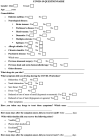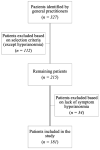Hyposmia in COVID-19: Temporal Recovery of Smell: A Preliminary Study
- PMID: 37763630
- PMCID: PMC10535790
- DOI: 10.3390/medicina59091511
Hyposmia in COVID-19: Temporal Recovery of Smell: A Preliminary Study
Abstract
Background and Objectives: Hypo/anosmia is a characteristic symptom of COVID-19 infection. The aim of this study is to investigate the time of smell recovery and to identify a possible order of perception recovery of different odors in COVID-19 patients. Materials and Methods: A prospective observational study was conducted on not hospitalized COVID-19 patients, selected according to eligible criteria. The study was approved by the Ethical Committee. A questionnaire formulated by our team was submitted to patients in order to know the duration of the hypo/anosmia and hypo/ageusia and the order of odor recovery: vanillin (mixed olfactory/gustatory substances), phenyl ethyl alcohol (rosewater) (pure olfactory substances), eucalyptol (mixed olfactory/trigeminal substances), and eugenol (mixed olfactory/trigeminal/gustatory substances). Results: 181 patients were included. Hypo/ageusia and hypo/anosmia lasted on average 10.25 (±8.26) and 12.8 (±8.80) days, respectively. The most frequent odor recovery sequence was: (1) phenyl ethyl alcohol; (2) eucalyptol; (3) vanillin; and (4) eugenol. In COVID-19 patients, hypo/anosmia occurs more often in women and at a young age. Conclusions: This preliminary investigation highlighted novel data: there is a chronological order in perception recovery of different olfactory substances and, therefore, in the restoration of the various sensitive nerve pathways involved in the sense of smell.
Keywords: anosmia; coronavirus; hyposmia; olfaction disorders; olfactory perception.
Conflict of interest statement
The authors declare no conflicts of interest.
Figures





Similar articles
-
Physiological discrimination and correlation between olfactory and gustatory dysfunction in long-term COVID-19.Physiol Rep. 2022 Nov;10(22):e15486. doi: 10.14814/phy2.15486. Physiol Rep. 2022. PMID: 36412058 Free PMC article.
-
Long-Term Subjective and Objective Assessment of Smell and Taste in COVID-19.Cells. 2022 Feb 24;11(5):788. doi: 10.3390/cells11050788. Cells. 2022. PMID: 35269410 Free PMC article.
-
Post-COVID-19 patients suffer from chemosensory, trigeminal, and salivary dysfunctions.Sci Rep. 2024 Feb 11;14(1):3455. doi: 10.1038/s41598-024-53919-y. Sci Rep. 2024. PMID: 38342941 Free PMC article.
-
Olfactory and Gustatory Dysfunction in 2019 Novel Coronavirus: An Updated Systematic Review and Meta-analysis.Int J Prev Med. 2021 Dec 14;12:170. doi: 10.4103/ijpvm.IJPVM_484_20. eCollection 2021. Int J Prev Med. 2021. PMID: 35070203 Free PMC article. Review.
-
Possible Use of Phytochemicals for Recovery from COVID-19-Induced Anosmia and Ageusia.Int J Mol Sci. 2021 Aug 18;22(16):8912. doi: 10.3390/ijms22168912. Int J Mol Sci. 2021. PMID: 34445619 Free PMC article. Review.
References
-
- World Health Organization WHO Director-General’s Opening Remarks at the Media Briefing on COVID-19. Jan 11, 2021. [(accessed on 13 February 2021)]. Available online: https://www.who.int/director-general/speeches/detail/who-director-genera....
-
- World Health Organization WHO Director-General’s Opening Remarks at the Media Briefing on COVID-19. Mar 11, 2020. [(accessed on 13 February 2021)]. Available online: https://www.who.int/director-general/speeches/detail/who-director-genera....
-
- Lechien J.R., Chiesa-Estomba C.M., De Siati D.R., Horoi M., Le Bon S.D., Rodriguez A., Dequanter D., Blecic S., El Afia F., Distinguin L., et al. Olfactory and gustatory dysfunctions as a clinical presentation of mild-to-moderate forms of the coronavirus disease (COVID-19): A multicenter European study. Eur. Arch. Otorhinolaryngol. 2020;277:2251–2261. doi: 10.1007/s00405-020-05965-1. - DOI - PMC - PubMed
Publication types
MeSH terms
Substances
LinkOut - more resources
Full Text Sources
Medical

